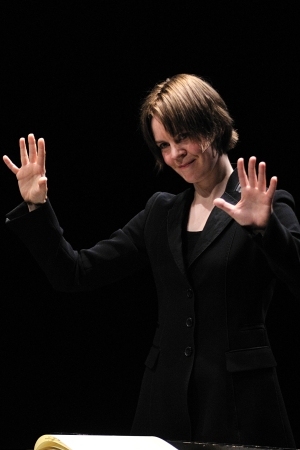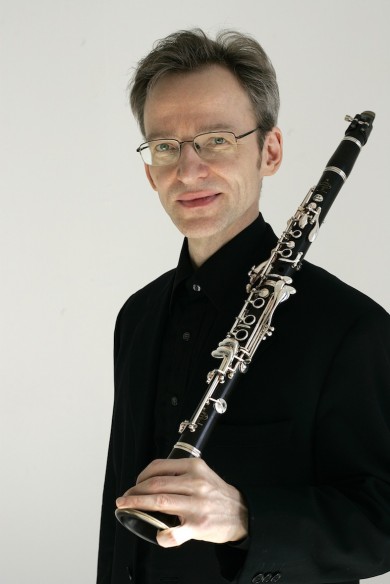Mälkki, New World deliver riveting Berlioz and the American premiere of Saariaho concerto

Susanna Mälkki conducted the New World Symphony in music of Saariaho and Berlioz Saturday night in Miami Beach.
The musical bounty of contemporary Finland took the stage Saturday in Miami Beach, as conductor Susanna Mälkki led a performance by the New World Symphony that was both exhilarating and thought-provoking.
Mälkki, a contemporary music specialist in her final season as music director of the Paris-based Ensemble InterContemporain, has become one of the world’s most sought-after podium guests. Conducting at New World Center without a baton, she showed a mastery of the orchestra, leading it through subtle and sudden changes in dynamics, with tight ensemble work and sizzling intensity in a concert that included the U.S. premiere of a new clarinet concerto and Berlioz’s Symphonic fantastique.
The concert opened with the Clarinet Concerto by the Finnish composer Kaija Saariaho, given its premiere in Helsinki in 2010 and inspired by a famous, cryptic series of medieval tapestries called The Lady and the Unicorn. “I started to imagine the clarinet as a unicorn,” the composer explained, in a video projected above the stage before the performance. “I started to ask myself what kind of sounds would a unicorn make?”
A unicorn, apparently, would make the sounds of a clarinet stretching its technique to the outer limits, with high notes beyond anything normally heard from the instrument, including multiphonics—the production of two or more simultaneous tones—weird growls and shrieking glissandos. The Finnish clarinetist Kari Kriikku, for whom the work was composed, handled all this expertly while moving around the hall in a way that threw out the traditional concerto performance style in which the soloist remains planted in front of the orchestra.

Kari Kriikku
The concerto’s six movements depict the six tapestries—projected above the stage—which are named after each of the five senses and a mysterious sixth one. Saariaho makes physically manifest the implied drama of the concerto form, by choreographing the clarinetist’s movements around the hall, and on stage, as he engages members of the wind section in quick passages of musical dialogue, with each musician standing up for a brief musical confrontation with Kriikku, the soloist.
The work opened with the clarinet offstage, as misty, harmonically dense, impressionistic sounds emerged from the orchestra. From some unseen place came the sound of the clarinet—wild, uncivilized, with growls, shrieks and nothing resembling a melody. The unicorn has arrived.
At the opening of the second movement, the clarinetist appeared, suddenly spotlighted on the steps in the middle of the audience. Kriikku worked his way down the steps and joined the orchestra on stage. Throughout, the orchestra played sedate, pulsing, atmospheric tones as the clarinet went on feral cadenza-like romps. Although it wasn’t obvious how these sections depicted the sense, this performance was completely absorbing—in significant part due to the visual dramatics.
The movement devoted to the sense of touch came as something of a musical relief, with strongly marked rhythms providing a bracing contrast to the foggy character of the earlier movements. In the final movement, the music faded away over the course of minutes, and then came a bizarre episode that fittingly capped this highly original work: Members of the violin section stood up one by one, still playing high, soft note patterns and walked slowly off stage, as the clarinetist, like the Pied Piper of South Beach, led them into the audience.
Mälkki drew a subtle, richly colored performance from the New World musicians, keeping pace with the soloist’s improvisatory wanderings. Members of the orchestra participated gamely in the choreography, while delivering assured playing in a challenging, logistically difficult work.
The second half of the concert was devoted to Berlioz’s Symphonie fantastique, a work that portrays the opium-induced hallucinations of a morbid young musician in love. Given Mälkki’s specialty in contemporary music, you might expect her to exaggerate the modernist elements of this path-breaking 1830 work. But while the climactic moments came with unaccustomed ferocity and shock—as in the terrifying bellows from the brass and the double timpani thumping as loud as you’re ever likely to hear—there was also a classical precision to the performance. The orchestra played with great clarity, with the conductor at points encouraging the woodwinds to increased volume, allowing their melodies and inner voices to be heard.
Mälkki’s domination of the orchestra allowed her to bring out the work’s sudden mood changes, from the druggy shifts in dynamics in the first section to the development of the second section’s waltz into a melody that was at once slightly out of control and nostalgic. The “March to the Scaffold” movement, in which the protagonist imagines he’s being executed for murdering his beloved, came off with enormous intensity, showing the excitement that can be generated by high-speed ensemble precision—concluding a performance that was riveting and somewhat frightening—as Symphonie fantastique should be.
The program will be repeated 2 p.m. Sunday at New World Center in Miami Beach. nws.edu; 800-597-3331.
Posted in Performances
2 Responses to “Mälkki, New World deliver riveting Berlioz and the American premiere of Saariaho concerto”
Leave a Comment
Sun Dec 16, 2012
at 1:57 pm
2 Comments
Posted Dec 19, 2012 at 12:40 pm by Winslow Shea
My wife and I truly enjoyed last week’s New World concert on Miami Beach, especially the US premiere of the Clarinet Concerto by the Finnish composer Kaija Saariaho, inspired by the famous Unicorn tapestries in the Cluny Museum in Paris. Two elderly men next to us, tho younger than us, didn’t like it all, however, and one rose to say he couldn’t wait to see the review in the Herald. He expected, or hoped, for the worst. But I knew he’d be disappointed. It was a wonderful piece, and a wonderful performance by the orchestra, its Finnish conductor, and the star clarinetist, Kari Kriikku, who pranced down the upper balcony steps right beside us, waving his clarinet wildly before him while avoiding crashing down the steps.
Your reviewer, David Fleshier, was puzzled by the “dueling” scenes between him and a few male clarinet and horn players from the orchestra, though. What did that have to do with the Lady and the Unicorn and the Five Senses? Nothing, really. But I bet it had a lot to do with the Hunting of the Unicorn tapestries in the Cloisters Museum in NYC. And I bet Kriikku’s entire balletic performance had a lot to do with Nijinski’s electrifying dance to Debussey’s “Afternoon of a Faun.”
Our gifted composer had more cards on the table than she showed in the short video clip!
Here are links to two illustrated articles on those famous predecessors, for those interested: The Hunting of the Unicorn Tapestries: http://www.ancientworlds.net/aw/Post/1192506
Mallarme & Debussy, The Afternoon of a Faun, here: http://www.ancientworlds.net/aw/Article/1262762
Posted Jul 15, 2013 at 8:14 pm by Steven Sanders
The response from Winslow Shea is characteristic of the erudition, taste, and sense of humor of the philosophy professor I had the good fortune to come into contact with while I was a graduate student at the University of North Carolina at Chapel Hill. I hope all is well with you and yours, Win.